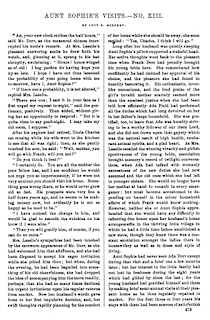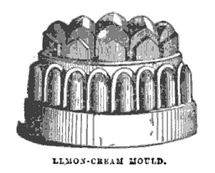While researching Christmas trees a few years ago, I encountered a series of stories in Godey's. "Aunt Sophie's Visits" were published in fourteen installments between 1857 and 1864. In each story, the eponymous heroine visits a relative, and gives them life advice. They are the sort of didactic story which I find enlightening about household details, so I started tracking them down.
While most of the stories are less useful for material culture than I had hoped, I think they offer some interesting insights into ideals about how families and marriages should function c.1860.
I. (November 1857) Aunt Sophie visits a newly married niece, and advises her on self-care.
II. (December 1857) Aunt Sophie instructs a different niece on preparing a Christmas tree [with strings of parched corn, dyed egg shells, riddles, lace bags of sweetmeats, paper ornaments, and wax lemons.]
III (July 1858) Aunt Sophie helps her nephew and his wife lay foundations for a good marriage and dealing with the loss of a child
IV (November 1858) Aunt Sophie teaches her husband's nephew to save and not to be extravagant with money.
V. (March 1859) Aunt Sophie advises her sister-in-law on being a stepmother, and the family comes together after the death of a child.
VI. (July 1859) Aunt Sophie visits her niece, and helps her niece's new husband realize that a person can be good without being dour. Includes references to picnics (with outdoor dancing), summer amusements, and Fourth of July celebrations.
VII.(March 1860) Aunt Sophie advises her brother and sister-in-law about assessing the character of their daughter's suitor.
VIII. (October 1861) Aunt Sophie cautions her niece about pride and shows kindness to a worthy friend fallen on hard times.
IX. (April 1861) Aunt Sophie visits her sister, models moderation in diet, and advises her niece on the salutary benefits of anticipating pleasant events.
X. (November 1861) Aunt Sophie helps her niece and her niece's husband to find contentment in their marriage, which started inauspiciously.
XI (February 1862) Aunt Sophie advises her friend(?) to help raise her motherless nephew, to the great improvement of his character.
XII (August 1862) Aunt Sophie visits her nephew's widow, and encourages her to have her children help with the household work--easing their mother's cares while providing structure for the children and helping them develop industrious habits.
XIII:(November 1862) Aunt Sophie advises her niece-by-marriage on balancing household and social duties (with bonus Wholesome Menus for Entertaining).
XIV (June 1863): Aunt Sophie advises her sister-in-law and nieces about choosing good reading material, including a cautionary tale about the dangers of bad novels and positive observations on the sublimity of nature.
*XV: (October 1863) Aunt Sophie, with her husband and two of their children, visit some old friends who have moved away. They discuss finding contentment in old age as in youth, and on the importance of avoiding addictive substances (tobacco and alcohol).
*XVI: (June 1864) Aunt Sophie visits her brother, and helps her new sister-in-law adjust to her new home. Much of the story is told from Mary's perspective, as a poor, but cheerful and hard-working orphan, wife and widow.
In the September 1863 issue of Godey's, a short notice announced the death of Lucy N. Godfrey in her home at Bethlehem, Vermont on May 21, 1863. The June 1863 issue, with installment XIV of the Aunt Sophie stories, would have been delivered the week she died. The announcement mentioned that the editors had one or two more of Mrs. Godfrey's stories on hand; these appeared in the October 1863 and June 1864 issues.
I was curious about the author's life, and how it may have related to her writing, which is focused on ideas for domestic harmony. Lucy Newman Godfrey (1829-1863) was the eldest of eight children. She appears to have spent her whole life in the vicinity of Brattleboro, Vermont, among a closely-knit family. At age twenty, she married Hartwell Godfrey, a mason five years her senior. Their only child was born in 1857, when Lucy was twenty-six and Hartwell thirty-one. In the only census taken during their marriage, Lucy and her son were living with her parents and siblings, while her husband boarded in New Jersey
Lucy's brother, George Newman Jr., may have had a wife named Lydia who died in 1857, the same year that he married a Sarah Caldwell. The fifth "Aunt Sophie" story, published in early 1859, features the heroine meeting her younger brother's second wife and advising her on relating to her stepchildren.
Lydia K. Newman, Lucy's possible sister-in-law, was predeceased by her daughter, Mary (1850-1853) and infant son, Orrin (1856). Stories three and five (published 1858/1859) include a family coping with the death of a child. The extended Newman family, unfortunately, experienced this grief multiple times in the years to follow.
In January 1863, Lucy's husband died of consumption, leaving her a widow with a 6-year-old son. In the final "Aunt Sophie" story (written by May 1863, published 1864), the character Mary's husband dies suddenly of consumption, leaving her a widow with several young children; her greatest help and comfort is her oldest son, aged 8. This story differs from the others, in that much of the narration is Mary telling her history to Sophie; most characters' backstories are given by the omniscient narrator, or by Sophie talking with a third party. The story also focuses on a second marriage for two parties: a melancholy widower who is financially secure, and a persevering widow who has always been poor. With a minimum of Sophie's advice (that Mary needed to resume some of her former occupations), the marriage provides them both with stability and companionship. I have to wonder if that's how Lucy hoped her own life might proceed after widowhood.











